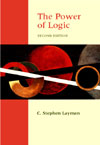|
 |  The Power of Logic, 2/e C. Stephen Layman
What's NewWhat’s New in the Second Edition? - The terminology regarding basic concepts has been streamlined. For example, "sound argument" replaces "deductively sound argument," "unsound argument" replaces "deductively unsound argument," "cogent argument" replaces "inductively sound argument," and "uncogent argument" replaces "inductively unsound argument."
- The discussion of validity and invalidity in chapter 1 is followed by a discussion of argument forms and counterexamples. This provides for an immediate application of the concepts of validity and invalidity (before moving on to the concepts of strength and weakness).
- Informal fallacies are categorized more simply and clearly as belonging to three main types. Approximately 40 new items have been added to the exercises on informal fallacies and the "Fallacy of Complex Question" has been added to the list of fallacies.
- The discussion of enthymemes has been delayed and placed in a more standard location, as part of the treatment of categorical syllogisms.
- The treatment of categorical logic has been expanded from one chapter to two, thus providing a more typical breakdown of topics, including The Traditional Square of Opposition, Further Immediate Inferences (Conversion, Obversion, and Contraposition), Venn Diagrams, the Modern Square of Opposition, Enthymemes, Sorites, Removing Term Complements, and the Aristotelian rules for evaluating syllogisms.
- Additional items have been added to many of the exercise sets throughout the book. This is especially so in Chapters 8 (Statement Logic: Proofs) and 9 (Predicate Logic), where additional, challenging items have been added to virtually every exercise set.
- The treatment of the most advanced material in the chapter on predicate logic has been expanded from two sections to four: The Logic of Relations (Symbolizations), The Logic of Relations (Proofs), Identity (Symbolizations), and Identity (Proofs).
- To facilitate quick and easy review, many new summaries of key points and procedures have been placed in boxes for the second edition.
|
|
|



 2002 McGraw-Hill Higher Education
2002 McGraw-Hill Higher Education

 2002 McGraw-Hill Higher Education
2002 McGraw-Hill Higher Education